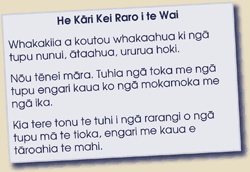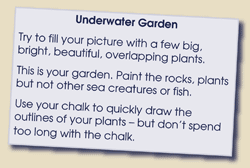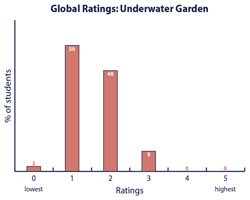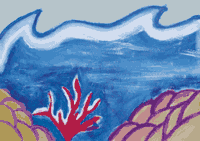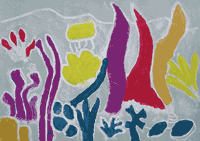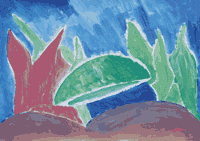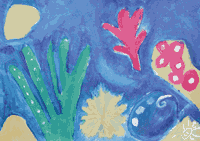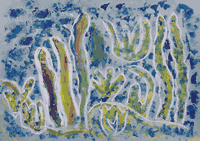He
maki rorohiko tënei, e 45 meneti te roa.
Ka noho ngä äkonga ki mua i te pouaka whakaata rorohiko,
ki wähi kë atu i ö rätou tëpu.
Me noho tonu ngä türu ki te taha o te mata rorohiko,
kaua e whakahokia ki ngä tëpu.
Me tü ngä äkonga ki te whakatutuki i ä rätou
mahi peita.
He mahi peita tënei. He tioka kei ngä tëpu hei
hoahoa i ä koutou pikitia, me ngä tae peita e ono.
Mä te whakaranu i ënei peita, e puta ai ngä tae
katoa. E taea ana ngä peita te whakaranu ki runga tonu i
te pikitia. Me whakaranu anö te peita mä, kia äta
kitea ngä tae i runga i te pepa. Ki te hiahia koutou ki ëtahi
peita anö, me tono mai ki ahau.
He rahi tonu ngä peita. E toru anö ngä momo paraihe,
he wai, e rua hoki ngä maramara hautai. Whakamahia tëtahi
o ngä hautai hei whakapaipai, hei whakamaroke i ngä
paraihe i mua i te whakamahinga i tëtahi atu tae.
E pai ana te whakamahi i ngä paraihe, i ö koutou matimati,
i tëtahi maramara hautai ränei hei whakatutuki i te
mahi peita, kia rerekë anö te ähua o te peita.
E 45 meneti hei whakaoti i ä koutou pikitia,
ä, me whakapau te katoa o taua wä.
Me äta whakarongo ki ngä whakamärama mö te
ähua o te pikitia. He pai pea kia katia ö koutou karu,
kia rongo ai tö hinengaro i taku whakamärama.
Whakahautia ngä äkonga kia katia ö rätou karu
i a rätou e whakarongo ana ki te whakamärama e whai
ake nei.
Whakaarohia he uri koe nö Tangaroa. Kei roto koe i
te moana e kimi kai ana, e kimi ana i tëtahi wähi
huna. Engari ko te korekore kei ö taha katoa. Kua kore
he aha hei whakaihiihi i a koe. Ko te wai moana anake. Ko te
mea e tino hiahia ana koe, ko tëtahi mära miharo ätaahua,
he huhua ngä momo tipu me ngä momo toka i roto. E
hiahia ana koe kia mïharo tonu tö noho ki te moana,
kia ngahau, kia pïataata.
Ko täu mahi, he peita i tënei mära miharo –
te mätotoru o ngä tipu e whakamiharo ana i te tirotiro
a te karu, hei wähi täkaro, hei wähi huna hoki.
Mä tö hinengaro e whakaaro te hanga o ënei momo
tipu – he tipu nui, he pïataata, he miharo hoki ngä
tae me te noho mai o ngä ähua, tëtahi ki runga
i tëtahi. Äkene pea he rua hei kauhoe mäu, he
toka hei huna i raro. Ina titiro whakarunga, he miharo, he ätaahua
te ähua o te aho e känapanapa mai ana i te mata o
te wai.
Huakina ö koutou karu, ka mätaki ai i te pouaka ataata.
He äwhina anö kia puta ai ngä whakaaro ki tö
hinengaro mö te ähua o ngä tipu i roto i te mära
miharo i raro i te moana, me te noho whakapiripiri o ënei
tipu.
Whakaaturia te whiti ataata.
|
|
This
activity uses the computer.
Seat students around the computer, away from their table spaces.
Keep the chairs at the computer rather than allowing them to be
taken back to tables. Students stand to paint.
In this activity you will be making a painting.
On your table you each have a piece of chalk for planning your
picture, and a palette with six colours of paint. With these colours
you can make almost any other colours you want by mixing and blending
your paints. You can mix colours directly on the painting. You
will need to mix white with your colours to help them show upon
the paper. If you need more paint you can ask me, because we have
plenty. You also have three different kinds of paint brushes,
some water and two pieces of sponge. Use one piece of sponge to
clean and dry your brush each time before you change to a different
colour of paint. Sometimes you can use your brushes, your fingers
or a piece of sponge to paint with. They will give you different
kinds of marks.
You will have 45 minutes to make your picture,
and I want you to use all of that time for painting.
Now listen carefully as I explain what your painting is to show.
It might help if you close your eyes and try to see in your imagination
what I am explaining.
Encourage students to close their eyes
as they listen to the following description.
Imagine you are a sea creature hanging about looking for somewhere
to feed and hide, but your space is full of emptiness.
It’s so dull and uninteresting for you. You’ve got
nothing but water.
What you would really like is a beautiful, magical underwater
garden with all sorts of unusual and wonderfully coloured magical
plants and rocks.
You want your life in the water to be bright, interesting and
full of fun.
In your painting you are going to paint this magical garden
with some plants that are overlapping and unusually exciting
to look at, play in and hide in. These will be make-believe
plants – plants that are big, bright and magical in their
colours and overlapping shapes.
There might be underwater caves to swim through and rocks to
hide under.
When you look up the plants in your garden will create wonderful
dappled patterns of light rippling on the surface of the water.
Open your eyes now and look at the video which will also help
you to think about the plants in your magical underwater garden,
and the way they clump together and behind each other.
Click
the Underwater Garden button. The video will start. |


